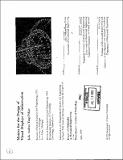| dc.contributor.advisor | Woodie C. Flowers. | en_US |
| dc.contributor.author | Yang-Peláez, Julie Anshun, 1970- | en_US |
| dc.contributor.other | Massachusetts Institute of Technology. Dept. of Mechanical Engineering. | en_US |
| dc.date.accessioned | 2005-08-22T20:15:00Z | |
| dc.date.available | 2005-08-22T20:15:00Z | |
| dc.date.copyright | 1999 | en_US |
| dc.date.issued | 1999 | en_US |
| dc.identifier.uri | http://hdl.handle.net/1721.1/9313 | |
| dc.description | Thesis (Ph.D.)--Massachusetts Institute of Technology, Dept. of Mechanical Engineering, 1999. | en_US |
| dc.description | Includes bibliographical references (p. 87-89). | en_US |
| dc.description.abstract | In product development, designers are often faced with the daunting tasks of interpreting, filtering, and managing enormous . amounts of information. Examples include marketing data, product specification data, and project scheduling data. Although potentially useful .information is buried in mountains of data, few tools exist to help users extract relevant information from these databases. Product developer need this pertinent information for more informed and therefore, more effective decision-making. This thesis explores the use of visualization techniques to reveal the inter-relational information hidden in databases. Visual displays enable designers co make decisions based on the overall relations in a database rather than the individual pieces of data. Information visualization has recently become a topic of significant interest especially with the availability of graphically agile computers, increased computational power: and advanced communication capabilities. It is a relatively new field of research where several point designs of new visualization techniques and tools have been proposed and developed. The premise of chis thesis is chat visual displays of information take advantage of the visual processing capabilities of humans, which leads to the identification of trends and patterns in data. Unfortunately, little is known about how to measure the effectiveness of visualizations. Based on a representational framework, a task-dependent approach, and a measure of information content, this thesis establishes metrics for the design of visual displays of information. To investigate the efficacy of these techniques, visualization tools were developed for exploring the patent database, a publication database, and the product development process. Empirical resting of the patent database visual tool demonstrated an increase in the capabilities of the designers using the visualization tool. | en_US |
| dc.description.statementofresponsibility | Julie Anshun Yang-Peláez. | en_US |
| dc.format.extent | 89 p. | en_US |
| dc.format.extent | 6851082 bytes | |
| dc.format.extent | 6850841 bytes | |
| dc.format.mimetype | application/pdf | |
| dc.format.mimetype | application/pdf | |
| dc.language.iso | eng | en_US |
| dc.publisher | Massachusetts Institute of Technology | en_US |
| dc.rights | M.I.T. theses are protected by copyright. They may be viewed from this source for any purpose, but reproduction or distribution in any format is prohibited without written permission. See provided URL for inquiries about permission. | en_US |
| dc.rights.uri | http://dspace.mit.edu/handle/1721.1/7582 | |
| dc.subject | Mechanical Engineering. | en_US |
| dc.title | Metrics for the design of visual displays of information | en_US |
| dc.type | Thesis | en_US |
| dc.description.degree | Ph.D. | en_US |
| dc.contributor.department | Massachusetts Institute of Technology. Department of Mechanical Engineering | |
| dc.identifier.oclc | 44012770 | en_US |
